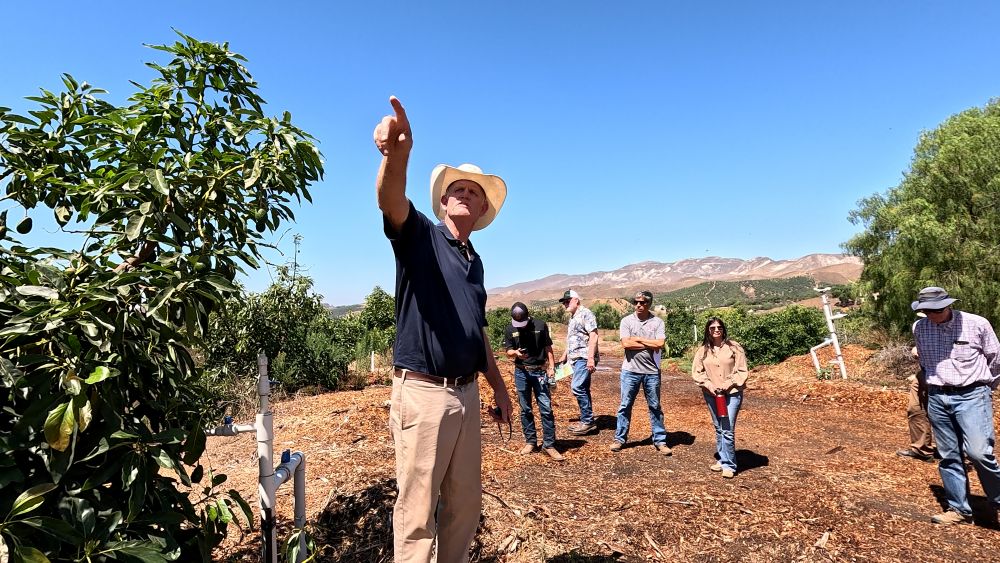You’ve never been to an avocado grove like John Schoustra’s. At least I haven’t.
From afar, it’s just avocado trees on some hills and it doesn’t appear unique. But up close, and with a guide to explain what you are seeing, you realize that the grove is a petri dish of experiments.
Schoustra’s avocado grove is a land of a hundred tests: rootstocks and varieties, plant spacings and arrangements, pruning techniques, watering methods and amounts, mulch and (no) fertilizer, weeds and (no) imported honeybees or sprays for pests, and more.
We didn’t have time to visit and discuss every aspect of what Schoustra has done in his grove during this brief tour after a seminar for the California Avocado Society in late August. In fact, the seminar was focused on fire. Last November, this area burned in the Mountain Fire. In the video, you hear references to that fire and its damage. (And see my post about it here.) But the tour gives you a taste of what Schoustra is doing, and you can see the results.
Below the video, I made notes on a few points Schoustra makes during the tour, particularly so we can apply some of what he has learned, even if we have a single avocado tree in a small yard.
Notes
About reducing the size of large avocado trees and making them produce “teenage” wood and fruit loads, Schoustra refers to this seminar by Claudio Hernandez Artaza.
Schoustra planted, and continues to plant, Lamb avocado trees grafted onto a rootstock called G-6. His trees come from a nursery in Fallbrook, San Diego County, called Maddock. As far as I know, Maddock Ranch Nursery is the only one making avocado trees with G-6.
I have a few young trees on G-6 at my place that are doing well, and I have seen older trees elsewhere doing well. G-6 is a “workhorse” rootstock, as one of the Maddocks once described it to me, and is a good option for home growers especially because of its availability from Maddock. (Many other specialty avocado rootstocks are only available to farmers.)
Relying only on wild bees and flies for pollination is bold for an avocado farmer. I was just at a farm yesterday where the manager grows hedgerows of flowering plants to feed wild pollinators and said he’d love to try a year of pollination without bringing in boxes of honeybees, but it’s just too risky.
I noticed in 2023 that native bees and flies can do an excellent job of pollinating avocado flowers. See my observations in my post, “Who pollinates avocado flowers?”
These pollinators will only live in your yard or farm if you feed them, and as John Schoustra shows, you don’t have to buy special plants to do this. I’m reminded of my posts, “What is good about weeds” and “Curating your yard’s weeds.”
Almost all organic avocado groves I know in California appreciate and apply mulch, but they also add fertilizers. After planting day, Schoustra adds only tree trimmers’ wood chips. Zero fertilizers.
(You can see me dig into the mulch under Schoustra’s trees a few years ago in this video and you can also read some details in this interview.)
I want to emphasize that because almost everyone (farmer and home grower alike) is convinced that healthy avocado trees and abundant crops cannot be accomplished so simply. They can. They are.
Thank you for your support so I can keep this website ad-free!
All of my Yard Posts are listed here




Thanks for the link to Chip Drop. On their site they have link to a This Old House video on how much mulch it too much.
Thanks, Dave. I just watched it. Funny thing is there were no wood chips in the video! It’s all compost. Nevertheless, since it’s applied to the surface it is rightly called mulch.
This is a good idea
I love how the world is embracing organic farming.
It’s the healthier means of farming. This is my are of specialisation am Agricultural Extensionist from Kenya
Greetings to you in Kenya, Ninah. Good to hear of your work there.
Thanks Greg, fascinating and very helpful video and post.
Thanks for this fascinating and well edited video. John Schoustra is a pioneer with low risk aversion. Wood chips are low in nitrogen and wild pollinators are iffy. How in the world did avocados survive and reproduce before additional fertilizers and only wild bees and flies? Looks as though he’s finding out!